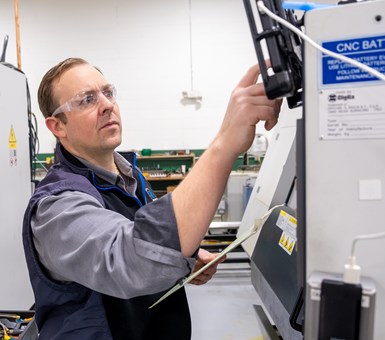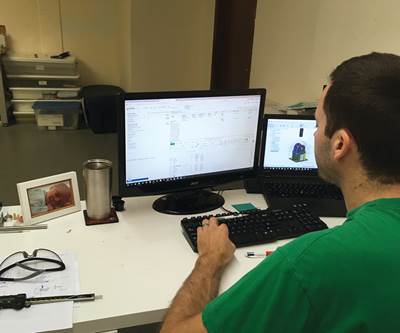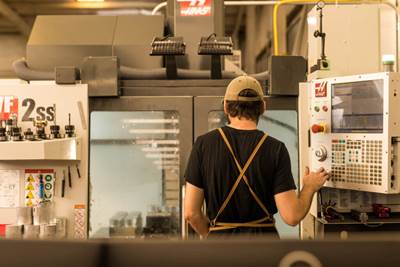Sometimes No-Quoting RFQs is Essential for Efficiency
Accepting only RFQs that work toward a company’s goals and learning how to manage those efficiently can build better businesses and customer relationships.
Share





Autodesk, Inc.
Featured Content
View More.png;maxWidth=45)
DMG MORI - Cincinnati
Featured Content
View More
Having the resolve to no-quote or turn down requests for quotes (RFQs) is a trait shared by successful machine shops. Managing only the quotes that are in alignment with a shop’s core competencies and goals will build a strong foundation for a profitable and efficient business, while also establishing solid customer relationships.
The kind of RFQs a shop no-quotes, the speed at which it replies to an RFQ, how it prioritizes quotes and its quote-to-book ratio are all key components for effectively managing RFQs. Here, three shop owners and one software provider share strategies for handling RFQs and describe why building relationships is important when doing so, even when no-quoting.
Which RFQs to Refuse
Because a shop can only handle work that is in its wheelhouse, it is usually easy to know which RFQs should be no-quoted. The shop simply does not have the appropriate equipment to accept some jobs. But even when the capability is there, it still is sometimes better to no-quote.
“We generally avoid super high-quantity RFQs because we usually cannot compete with prices coming from China,” says Rick Paulson, president, Micro-Matics (Fridley, Minnesota). “We are a small-to-medium shop. We are not going to tie up most of our machines on one part number to try to compete on a price that we can’t compete on.”
“We aren’t going to waste their time if we can’t achieve what they are looking for from a lead time perspective.”
Doug Coster, president, Nolte Precise Manufacturing Inc. (Cincinnati, Ohio), says he no-quotes on a regular basis for the same reasons mentioned, but also if the lead time does not suit his company. “We might no-quote because they are looking for an unachievable delivery requirement at that time,” he says. “We aren’t going to waste their time if we can’t achieve what they are looking for from a lead time perspective.”
Risk is another reason why a shop might refuse a quote, according to Coster. “Jobs sometimes come across our desk that we might be able to do, but there’s enough risk involved that we don’t want to disappoint the customers.” He adds that risk should always be considered and that taking on risky projects can lead to relationship problems with a customer.
Even if a shop decides not to quote, communication with the company that requested the quote is still important, according to Jason Ray, CEO, Paperless Parts, a cloud-based quoting platform. “Radio silence is a big mistake,” he says. “There are simple steps to automating responses that let the company know you will get back with them. If they hear nothing, they have to assume that company is not taking a new customer, and then the shop gets put on a list not to contact.”
Before deciding to no-quote on face value, though, it is sometimes worth doing more digging. “If the opportunity could lead to more business, it could be worth the investment in time, resources and perhaps assets,” says Dan Villemaire, president, C&M Precision Tech (Hudson, New Hampshire). “For that reason, we often dive a little deeper, specifically for existing customers or strategic prospects. In many cases, taking measured risks allowed C&M to grow to what it is today,”
When to Let Go
Sometimes, letting go of RFQs from existing customers that once served the shop well is a smart decision. Paulson says he has let go of customers or at least part numbers in the past for reasons such as changes in payment terms or the customer changing criteria in the middle of the job.
Coster has also let go of a customer when it became evident that the demands were a distraction and drain on resources. “The relationship was a disconnect between our value system and what the customers processes and expectations were,” he explains. “It starts to send inconsistent messages within the organization and can impact morale and have hidden costs.” In this instance, he says the job looked good on paper, but had a negative impact on the team.

When a customer no longer appreciates the added value a shop gives, including customer service and inventory management, it might be time to consider pointing that customer in a new direction. (Photo courtesy of C&M Precision Tech.)
Villemaire let go of a customer when it stopped understanding the value his shop brought to its parts and started pinching pennies instead. “The part we were making for them became more of a commoditized item,” he says. “We had a lot of different part numbers for them — 1,000 active SKUs. Parts were being taken away from us without our knowledge and we were stuck with inventory. We feel like we bring value to our customers, from inventory management and customer service. When people start trying to get blood out of a rock, then we know the business is not a good fit for us.”
Not burning bridges and having an in-person meeting to break the news is Villemaire’s advice in handling long-term customers like this. “We were upfront and honest with the customer. We supported the transition of the project and supported their needs until the project was moved from our organization.” He says he still has a relationship with this customer and he attributes that to the way his company treated the difficult position it was in.
If a customer becomes married to a price that is no longer tenable, this may be another reason to let go of its business or part number, according to Ray. “It’s not a good sign when a customer won’t work with you on price increases. When shops aren’t making money on a job, they are hesitant to push back on that, but shouldn’t be,” he says. “You can say, ‘this is the only price we can make it at because we have so many other customers demanding our capacity since we deliver quality products.’”
Also, when a shop continues to quote a company but never wins a job from it, it may be time to stop sending quotes to that company, Ray says. “They are a drain on your resources and it’s time for a phone call.” But, he warns, “If you are too busy answering new quotes, you won’t have time for that phone call.”
Ray says he would not let go of a customer midcontract, but when the time is right, he would have a frank conversation about the problem and why the shop is letting go of its business.
How Fast to Respond
The time it takes for a shop to quote a part depends on the part complexity, but nothing else should get in the way of answering a quote quickly.
Ray believes many job shops are too slow to quote. “If it takes a day to get one quote out and you get five quotes in a day, then you will have a backlog,” he says. “The numbers grow, and it becomes more and more difficult. If you can send a quote out in an hour, a backlog is not an issue.”
“If you are last, some of the work might already be placed. We always want to be first on their plate.”
Since many companies sending out RFQs need a response quickly, it often benefits a shop to respond as fast as possible. Villemaire finds he is winning work because he can be the first to respond. “If your price is reasonable and quick, then it is often a reflection of your production process, too,” he says. “They think if we get this done quickly, then our process time will be quick as well.”
He adds that if a no-quote is necessary, it is best to inform the company as fast as possible.
Paulson says he wins work with a fast response as well. “It is something to be first on their desk,” he says. “If you are last, some of the work might already be placed. We always want to be first on their plate.”
Although Coster agrees that speed has an impact when it comes to winning a job, he also sees the situation strategically and does not think speed is always best. “If it’s the right component, right fit and right qualified lead, there’s enough time to do the proper due diligence to make sure you have a good quote versus a quick quote,” he says. “But there’s always a due date, and you need to hit that.”
Why Prioritize?
Some shops prioritize their RFQs to decide which ones to fill first, while others do so on a first-come, first-served basis.
Prioritizing RFQs is something Nolte Precise is thoughtful about. The shop may ask itself: Is it a qualified lead? Is it a current customer or target? Where is the part in the buying cycle? Is this something the customer is ready to buy or are they doing the RFQ for a different purpose? Where does it fit within our strategy?
Also, whether the RFQ is a transactional or transformational opportunity for the company is another question Nolte considers. “We think about if this is a company that really needs the part and wants to know how much it will cost and when we can deliver it, versus a company that sees the part, price, quality and delivery as important, but also wants to know more about us as a partner,” Coster explains.

Prioritizing RFQs is something Nolte Precise is thoughtful about. Doug Coster, company president, says his company asks itself several questions about an RFQ, including whether or not it is a transactional or transformational opportunity. (Photo courtesy of Nolte Precise.)
Due date is C&M Precision Tech’s first priority. “I don’t think there’s a perfect answer to how to prioritize,” Villemaire says. “Number one is due date, then customer relationship. Is it a new customer, high-maintenance customer or one that is good to you?”
Micro-Matics, however, does not prioritize customers. “We try to do first in, first out with all our customers,” Paulson explains. “If a customer needs a quick turn on something, we may try to prioritize that faster if our schedule allows it.”
Ideal Quote-to-Book Ratio
Knowing a proper quote-to-book ratio to target can be helpful to determine if a shop is quoting too high or too low on price. It is critical to focus less on increasing one’s win rate and more on increasing the dollars per part and doubling the number of quotes sent, says Ray from Paperless Parts. “I think if your win rate is over 35%, you are probably too low on price. Try to balance. By sending more quotes at a higher dollar value per quote, you’re going to win the work that is optimal for your shop and increase your bottom line,” he adds.
Paulson sees his quote-to-book ratio from a different point of view, however. For repeat part numbers, his ratio is 98%. “For customers I’m already doing business with, the ratio is in the 80% range, and new customers are below 10%,” he says. His theory is that if he already has the part and is making it, then he is already an approved vendor. He’s not going to raise the price, and he’s already getting a high percentage of the RFQs from that customer. “They keep it in the family,” he explains.
Paulson believes new customers are often trying to find a shop that can do the job for half a penny cheaper, and they are putting a lot of RFQs out there. “They are trying to get free quotes, and their net ratio is going to be a lot less,” he says.
No-Quote Relationships
In cases where a shop has attempted to make a quote work, but realizes it is not in its best interest to accept the quote, helping the company that requested the quote find a better source is ideal. This positive interaction is often the foundation of a new business relationship, one that can lead to other opportunities in the future.
“Whatever is best for the customer is best for me, is the way I look at it,” Paulson says. “If the customer has a best fit someplace else, I’m going to want what’s best for the customer. Next time, they are going to remember me as the person they can get an answer from. I want to be their problem-solver and add value to them to win no matter what.” He explains that by doing this he builds credibility with the company. “You have to differentiate yourself from more than just a quoting standpoint.”
Software that Eliminates Manual Processes
Many shops use their ERP systems to manage RFQs, but software is available (such as the platform from Paperless Parts) that streamlines processes and automates functions to make a shop more efficient. Communication with customers and

C&M Precision Tech uses RFQ software from Paperless Parts to streamline processes and automate functions to create more efficiency. Dan Villemaire (above), company president, says the software has helped his company set goals and work toward them.
vendors is made easier and prints can be sent securely to vendors. When an order is placed, the software creates a material master for the part number and auto creates a sales order and job — all things that were once done manually.
“These were processes that may not have taken a lot of time, but have a tendency to sit on someone’s desk and can go days without it getting put into the system,” Villemaire says. “With Paperless Parts, this is done automatically, creating a trigger visible in our ERP system and scheduling team.”
By working with Paperless Parts, C&M Precision Tech has been able to easily set goals and work toward them. It is possible to immediately identify jobs that are not a good fit and to set those parameters. “For us to be able to develop our own system would have been difficult and expensive,” Villemaire explains.
RFQ Resolution
When a shop understands its goals and core competency, no-quoting will happen naturally. The essential jobs to quote will be obvious and investing the time and effort in that work will be profitable, resulting in a smooth and successful workflow. But when a job is too risky or a threat to a shop’s resources, a no-quote is the better decision. Knowing the proper way to no-quote is the key to leaving the door open for future business without burning bridges.
C&M Precision Tech | 603-889-1330 | cmprecisiontech.com
Micro-Matics Inc. | 763-780-2700 | micro-matics.com
Nolte Precise Manufacturing Inc. | 513-923-3100 | nolteprecise.com
Paperless Parts | 617-475-0161 | paperlessparts.com
Related Content
What are Harmonics in Milling?
Milling-force harmonics always exist. Understanding the source of milling harmonics and their relationship to vibration can help improve parameter selection.
Read MoreSelecting a Thread Mill That Matches Your Needs
Threading tools with the flexibility to thread a broad variety of holes provide the agility many shops need to stay competitive. They may be the only solution for many difficult materials.
Read MoreHow to Determine the Currently Active Work Offset Number
Determining the currently active work offset number is practical when the program zero point is changing between workpieces in a production run.
Read More4 Commonly Misapplied CNC Features
Misapplication of these important CNC features will result in wasted time, wasted or duplicated effort and/or wasted material.
Read MoreRead Next
Quoting Tool is Key to Shop’s Growth
A medical device consulting firm decided to expand its business by taking on milling and turning work. It quickly stepped up its business by using an online quoting tool to access RFQs and land jobs.
Read MoreWhen It Comes to RFQ Response, Time Is Money
But in this case, the more time it takes, the less money you’re likely to make.
Read More



























.png;maxWidth=150)







.jpg;maxWidth=300;quality=90)

















